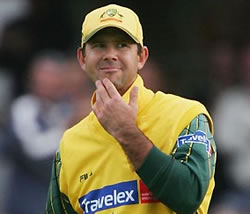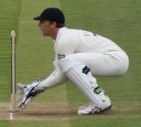Australia Overcome The Odds
Paul Wood |
A trip to India with your side handicapped by injury is not the most enticing proposition. Under such circumstances, it was thought Australia were to be the punchbags for India’s big hitters, especially when such vital componenents such as Brett Lee, Peter Siddle and James Hopes joined the likes of Nathan Bracken, Brad Haddin, Michael Clarke and Callum Ferguson back in Australia before the tour ended.
That of course is to slightly exaggerate the advantage India held, but you get the point. Australia were the unfancied favourites, yet injuries offered opportunities for fresh young individuals to state their cases, the perennial fringe players to finally steal some limelight, and for the more seasoned campaigners to relish the extra responsibility.
Both sides were unable to maintain momentum early on in the series, and that was reflected with the scoreline at 2-2 after four contests. While Australian were forgiven to an extent, due to the number of changes, India were guilty of not seizing the opportunities.
The opener in Vadodara produced a thriller, with Australia edging home by four runs. The second (Nagpur) was far more conclusive, this time in India’s favour with skipper MS Dhoni playing the near-perfect ODI innings. Cautious early but still managing to rotate the strike, in fact his running with Gautam Gambhir was a feature of their 119 run partnership, before Dhoni exploded with the kind of ferocious hitting he was famed for earlier in his career. It resulted in a sound 99 run win for the hosts.
Australia’s inability to contain in the last 10 overs was becoming a concern. They had been disposed for 87 and 108 respectively in the opening two matches, and certain death bowling skills were in need of more meticulous execution.
Australia’s total of 229-5 in Delhi during the third ODI never gave the impression of being enough, despite the pitch being slow and not conducive to the flowing strokeplay that was on show in Nagpur. Again it was Dhoni that led the way, along with Yuvraj Singh (the pair combined for a match-winning 148 run partnership), to give India a 2-1 series lead.
However, from here on it was Australia that dominated proceedings. After Australia made 250 in the fourth contest, you could be forgiven for thinking that it will be India that will now assume control, but the ability of any Australian side to not accept the seemingly inevitable was on show once more, and they fought and grafted their way back into the game, and the series, bowling India out for 226.
The experience within the Australian batting ranks, ultimately came to fruition, led by Mike Hussey, who was the epitome of consistency throughout. If his Test place is rumoured to be under threat, then his skills in the ODI format are matched by few in world cricket. He accumulated 313 runs at an average of 104.33, scored at just under a run a ball. His ability to construct a patient innings when necessary, or throw the willow during the dying embers of an innings are indeed equally effective and a complete understanding and clarity of his role is most obvious.
He did not play a lone hand, captain Ricky Ponting, Shane Watson, and Cameron White were all in good touch during the series, yet will be disappointed not to convert the many starts that were made, despite the exquisite form. The four form players crossed 50 on 10 occasions collectively, without a three figured score being registered, Watson also fell twice on 49. This statistic was overshadowed due to the consistent form of the batsmen as a unit.
India have been able to compete only with the rare outstanding cameo, one thinks automatically of Sachin Tendulkar’s phenomenal effort in the fifth ODI at Hyderabad. Set a monstrous 351 to win, India came out of the traps with Virender Sehwag in a typically pugnacious mood, but it was Tendulkar handing out the masterclass. He made 175 exquisite runs off 141 deliveries, including 19 fours and four maximums and in doing so gave the fans of the 50-over game more scope to argue that this format has a definite future in the calendar. His innings, and with it India’s hopes, ended as he attempted a Dilshan-style scoop, of which he got the height, but not enough distance. As a result India fell an unfortunate three runs short.
Only three centuries were made in the entire series, Tendulkar and Dhoni for India, and it was the relative novice Shaun Marsh that showed the Australians how it is done. More comfortable at the top of the order, it was his run a ball 112 in Hyderabad that took the game just out of Tendulkar’s reach. All of Australia’s top five played cameo innings of differing proportions in this fixture to emphasise the consistency that had been found, and provoke many selectorial discussion points down the line when Michael Clarke and Callum Ferguson return to fitness.
The series was clinched for Australia at Guwahati. Doug Bollinger, one of the aforementioned players that gleefully grabbed his opportunity, ran through the Indian side bowling them out for 170, and without a 74 run partnership for the eighth wicket it could have been much worse for the home side. Bollinger ran in and combined accuracy with pace, and finished with 5-35 off his allocation.
The last rites due to be administered in Mumbai did not take place due to torrential weather.
The odds on Australia losing so many players to injury, yet Shane Watson remaining ever-present, and picking up the Man of the Series award, would have offered many a person brave enough to take the bet a remaining life of retirement and ample comfort. Not only did he score 256 runs at 42.66, with an eye-catching strike rate of 91.10, but he was also the leading wicket-taker with 10 at 22.00.
The most economical bowler on show went to the ever-improving Nathan Hauritz. The very thoughtful off-spinner combines clever flight changes with an impeccably Australian line, and went for only 4.40 runs per over in his 52 overs in the series. The burgeoning development of Peter Siddle (who was also struck by injury during the tour) as an aggressive pace bowler continues. He fits nicely into the category of a ‘hit the deck bowler’, who delivers the ball at a very lively pace and maintains a disciplined back of a length, while using the fuller delivery accurately.
For India, while Dhoni and Tendulkar produced the kind of majestic innings we know they’re capable of, batting as a unit was more problematic. Late order power hitting, mainly from Harbhajan and Praveen Kumar, threatened to resurrect hopes and paper over the cracks of the top order deficiencies, but it was never enough.
Yuvraj Singh, Gautam Gambhir, Suresh Raina, and Virender Sehwag all flourished spasmodically, but never found the consistency to regularly trouble the patched up Aussie attack.
They lacked the old ball skills of a Zaheer Khan, and Ishant Sharma still looks a shadow of his former self despite one or two encouraging signs of the old Ishant returning. When Ashish Nehra and Praveen Kumar got the ball to swing, they were a handful. When conditions were not as favourable, Ponting and co had no hesitation in going on the attack.
It is not quite back to the drawing board for India, however, there may be one or two question marks over certain positions as the 2011 World Cup closes in. For Australia, they can be very proud of what they achieved in this series, and will be pleased that they have added depth and quality to the overall squad, and given exposure and experience to players that were otherwise unlikely to get a sniff. Their superiority in the one-day arena continues, for now at least.




Leave a comment